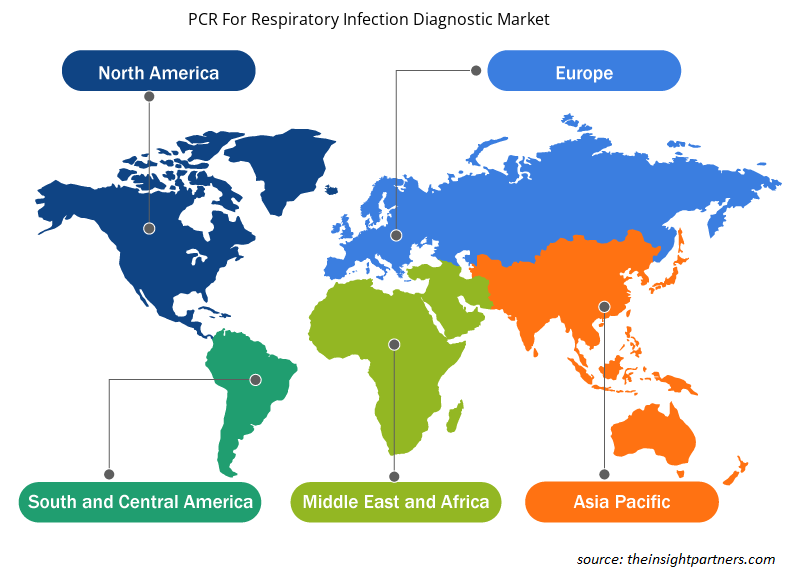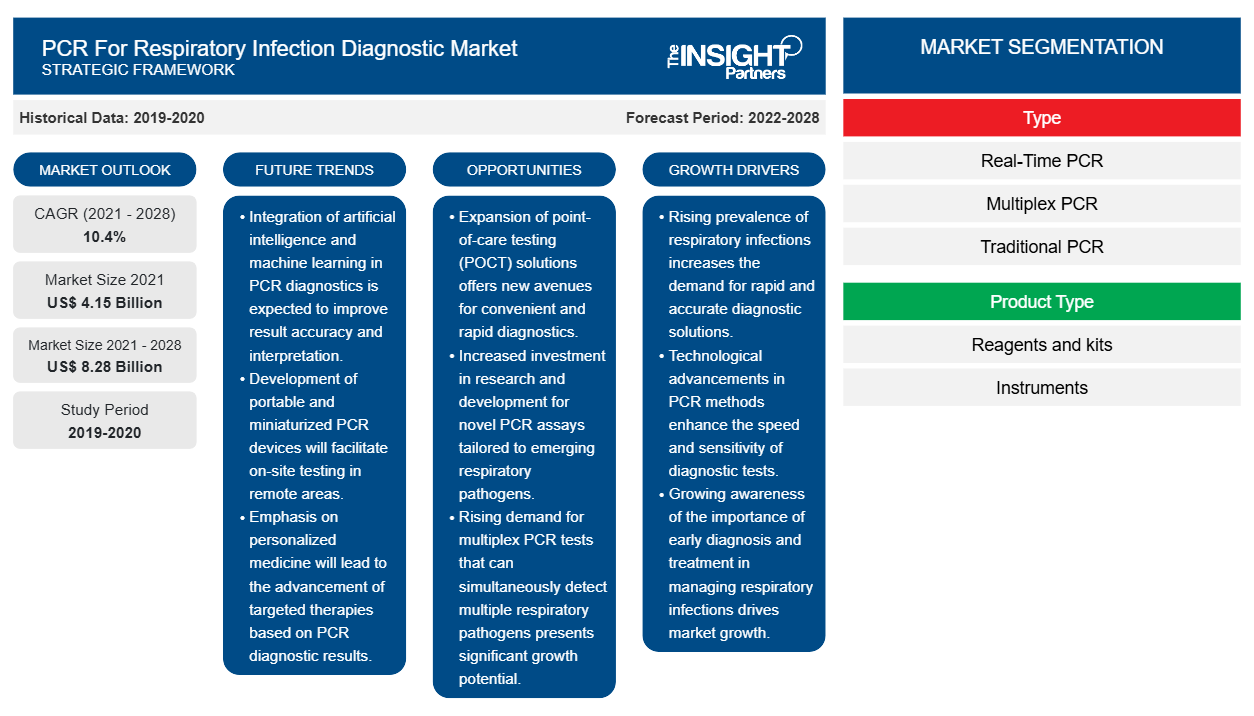Der Markt für PCR zur Diagnostik von Atemwegsinfektionen wurde von 4.146,02 Millionen US-Dollar im Jahr 2021 auf 8.279,32 Millionen US-Dollar im Jahr 2028 geschätzt; es wird geschätzt, dass er von 2021 bis 2028 mit einer durchschnittlichen jährlichen Wachstumsrate von 10,4 % wächst.
Die Polymerase-Kettenreaktion (PCR) wird für eine präzise Point-of-Care-Diagnostik verwendet, mit der sich die Ursache von Atemwegsinfektionen schnell identifizieren und bestimmen lässt. Darüber hinaus wird die PCR im stationären und ambulanten Bereich häufig eingesetzt, was zum Wachstum des Marktes in den letzten Jahren beigetragen hat.
Das Wachstum des Marktes für PCR zur Diagnostik von Atemwegsinfektionen wird auf Faktoren wie die zunehmende Belastung durch chronische Atemwegserkrankungen (CRDs) und die zunehmende Entwicklung von PCR-Tests zurückgeführt, die die Leistungsfähigkeit medizinischer Geräte deutlich verbessern. Allerdings werden PCR-Tests zur Diagnostik verschiedener Atemwegsinfektionen und Entwicklungen in der PCR-Technologie, die zu ihrer Ableitung verwendet werden, eingesetzt. Die Verfügbarkeit alternativer Tests behindert das Marktwachstum.
Passen Sie diesen Bericht Ihren Anforderungen an
Sie erhalten kostenlose Anpassungen an jedem Bericht, einschließlich Teilen dieses Berichts oder einer Analyse auf Länderebene, eines Excel-Datenpakets sowie tolle Angebote und Rabatte für Start-ups und Universitäten.
- Holen Sie sich die wichtigsten Markttrends aus diesem Bericht.Dieses KOSTENLOSE Beispiel umfasst eine Datenanalyse von Markttrends bis hin zu Schätzungen und Prognosen.
Markteinblicke
Marktkonsolidierungsstrategien durch Einsatz von PCR-Tests zur Diagnostik verschiedener Atemwegsinfektionen
PCR-Tests sind der Goldstandard für die Erkennung von Infektionskrankheiten der Atemwege, einschließlich SARS-CoV-2. Die zunehmenden Entwicklungen bei der PCR beschränken sich nicht nur auf COVID-19-Tests. Die kontinuierlichen technologischen Entwicklungen haben es Forschern ermöglicht, fortschrittliche PCR-Techniken zu geringeren Kosten zu entwickeln und ihre Komplexität zu begrenzen. Es wird erwartet, dass PCR-Tests ihre Möglichkeiten für die molekulare Diagnostik verbessern und ihre Rolle in Zukunft mit der fortschreitenden Entwicklung von Technologien wie Mikrofluidik und Sequenzierung der nächsten Generation stärken werden . Darüber hinaus werden PCR-Tests in Einrichtungen wie Pflegeheimen, Einrichtungen für chronische Erkrankungen und Krankenhäusern häufig eingesetzt, um Infektionen mit dem Influenzavirus zu erkennen, das Atemwegsausbrüche verursacht.
Darüber hinaus zählen akute und chronische Atemwegsinfektionen zu den Hauptursachen für Morbidität in Industrie- und Entwicklungsländern weltweit. Schätzungsweise sind akute Atemwegserkrankungen für fast 75 % aller akuten Morbiditätsfälle weltweit verantwortlich. Daher bieten verschiedene Unternehmen verschiedene PCR-Kits an, mit denen das Vorhandensein von Erregern von Atemwegserkrankungen nachgewiesen werden kann. Unternehmen wie bioMérieux SA und altona Diagnostics GmbH bieten beispielsweise eine breite Palette von PCR-Kits an, mit denen akute Atemwegsinfektionen der oberen oder unteren Atemwege nachgewiesen werden können. Neben der zunehmenden Häufigkeit akuter und chronischer Atemwegserkrankungen werden in naher Zukunft wahrscheinlich auch andere Faktoren wie Umwelt- und Klimabedingungen, Luftverschmutzung und die Entdeckung neuer Bakterien, Viren und Krankheitserreger wichtige Wachstumschancen für PCR-Tests zur Diagnostik von Atemwegsinfektionen bieten.
Typbasierte Erkenntnisse
Der Markt für PCR zur Diagnostik von Atemwegsinfektionen ist nach Typ in Echtzeit-PCR (qPCR), Multiplex-PCR, traditionelle PCR, digitale PCR, Reverse-Transkriptase (RT-PCR) und andere unterteilt. Das Segment Echtzeit-PCR (qPCR) hatte 2021 den größten Marktanteil und wird im Prognosezeitraum voraussichtlich die höchste CAGR auf dem Markt verzeichnen.
Produkttypbasierte Einblicke
Basierend auf dem Produkttyp ist der Markt für PCR zur Diagnostik von Atemwegsinfektionen in Reagenzien und Kits, Instrumente und Sonstiges unterteilt. Das Segment Reagenzien und Kits hatte 2021 den größten Marktanteil und wird im Prognosezeitraum voraussichtlich die höchste durchschnittliche jährliche Wachstumsrate (CAGR) auf dem Markt verzeichnen.
Erkenntnisse basierend auf Infektionstypen
Basierend auf dem Infektionstyp ist der Markt für PCR zur Diagnostik von Atemwegsinfektionen in bakterielle Infektionen, Virusinfektionen sowie Pilz- und andere Krankheitserreger unterteilt. Im Jahr 2021 hielt das Segment der Virusinfektionen den größten Marktanteil und wird im Prognosezeitraum voraussichtlich die höchste durchschnittliche jährliche Wachstumsrate (CAGR) auf dem Markt verzeichnen.
Endbenutzerbasierte Erkenntnisse
Basierend auf dem Endverbraucher ist der Markt für PCR zur Diagnostik von Atemwegsinfektionen in Krankenhäuser, Arztpraxen, klinische Labore, akademische und Forschungseinrichtungen, Biotech- und Pharmaunternehmen und andere unterteilt. Im Jahr 2020 hielt das Segment der klinischen Labore den größten Marktanteil und wird im Prognosezeitraum voraussichtlich die höchste durchschnittliche jährliche Wachstumsrate (CAGR) des Marktes verzeichnen.
Produkteinführungen und Zulassungen sind die von Unternehmen am häufigsten angewandten Strategien, um ihre globale Präsenz und ihr Produktportfolio zu erweitern. Darüber hinaus konzentrieren sich die Akteure auf dem Markt für Brustrekonstruktionen auf die Kooperationsstrategie, um ihren Kundenstamm zu vergrößern, was ihnen wiederum ermöglicht, ihren Markennamen weltweit aufrechtzuerhalten.
PCR für die Diagnose von Atemwegsinfektionen – regionale Einblicke
Die regionalen Trends und Faktoren, die den Markt für PCR zur Diagnose von Atemwegsinfektionen während des gesamten Prognosezeitraums beeinflussen, wurden von den Analysten von Insight Partners ausführlich erläutert. In diesem Abschnitt werden auch PCR-Marktsegmente und die Geografie in Nordamerika, Europa, im asiatisch-pazifischen Raum, im Nahen Osten und Afrika sowie in Süd- und Mittelamerika erörtert.

- Erhalten Sie regionale Daten zum PCR-Markt für die Diagnostik von Atemwegsinfektionen
Umfang des Marktberichts zur PCR zur Diagnose von Atemwegsinfektionen
| Berichtsattribut | Details |
|---|---|
| Marktgröße im Jahr 2021 | 4,15 Milliarden US-Dollar |
| Marktgröße bis 2028 | 8,28 Milliarden US-Dollar |
| Globale CAGR (2021 - 2028) | 10,4 % |
| Historische Daten | 2019-2020 |
| Prognosezeitraum | 2022–2028 |
| Abgedeckte Segmente | Nach Typ
|
| Abgedeckte Regionen und Länder | Nordamerika
|
| Marktführer und wichtige Unternehmensprofile |
|
PCR für die Diagnostik von Atemwegsinfektionen – Marktteilnehmerdichte: Auswirkungen auf die Geschäftsdynamik verstehen
Der Markt für PCR zur Diagnose von Atemwegsinfektionen wächst rasant, angetrieben durch die steigende Endverbrauchernachfrage aufgrund von Faktoren wie sich entwickelnden Verbraucherpräferenzen, technologischen Fortschritten und einem größeren Bewusstsein für die Vorteile des Produkts. Mit steigender Nachfrage erweitern Unternehmen ihr Angebot, entwickeln Innovationen, um die Bedürfnisse der Verbraucher zu erfüllen, und nutzen neue Trends, was das Marktwachstum weiter ankurbelt.
Die Marktteilnehmerdichte bezieht sich auf die Verteilung der Firmen oder Unternehmen, die in einem bestimmten Markt oder einer bestimmten Branche tätig sind. Sie gibt an, wie viele Wettbewerber (Marktteilnehmer) in einem bestimmten Marktraum im Verhältnis zu seiner Größe oder seinem gesamten Marktwert präsent sind.
Die wichtigsten Unternehmen auf dem PCR-Markt zur Diagnostik von Atemwegsinfektionen sind:
- Abbott
- F. Hoffmann-La Roche AG
- Hologic, Inc.
- Seegene Inc.
- AusDiagnostics
Haftungsausschluss : Die oben aufgeführten Unternehmen sind nicht in einer bestimmten Reihenfolge aufgeführt.

- Überblick über die wichtigsten Akteure auf dem Markt für PCR-Diagnostik für Atemwegsinfektionen
Nach Typ
- Echtzeit-PCR (qPCR)
- Multiplex-PCR
- Traditionelle PCR
- Digitale PCR
- Reverse-Transkriptase (RT-PCR)
- Sonstiges
Nach Produkttyp
- Reagenzien und Kits
- Instrumente
- Sonstiges
Nach Infektionstyp
- Bakterielle Infektionen
- Bordetella
- Streptococcus Pneumoniae
- Staphylococcus aureus
- Haemophilus Influenzae
- Moraxella catarrhalis (Kratzwedel)
- Mycoplasma Pneumoniae
- Chlamydophila Pneumoniae
- Legionellen
- Sonstiges
- Virusinfektionen
- Rhinoviren
- Grippevirus
- Schweres Akutes Atemwegssyndrom (SARS) CoV-2-Virus
- Respiratorisches Synzytialvirus (RSV)
- Adenovirus
- Enterovirus
- Parainfluenza
- Menschliches Metapneumovirus (hMPV)
- Sonstiges
- Pilze und andere Krankheitserreger
Nach Endbenutzer
- Krankenhäuser
- Arztpraxen
- Klinische Labore
- Akademische und Forschungseinrichtungen
- Biotech- und Pharmaunternehmen
- Sonstiges
Nach Geografie
- Nordamerika
- UNS
- Kanada
- Mexiko
- Europa
- Frankreich
- Deutschland
- Vereinigtes Königreich
- Spanien
- Niederlande
- Norwegen
- Italien
- Restliches Europa
- Asien-Pazifik (APAC)
- China
- Indien
- Japan
- Australien
- Südkorea
- Restlicher Asien-Pazifik-Raum
- Naher Osten und Afrika (MEA)
- Saudi-Arabien
- Vereinigte Arabische Emirate
- Südafrika
- Restlicher Naher Osten und Afrika
- Süd- und Mittelamerika (SCAM)
- Brasilien
- Argentinien
- Restliches Süd- und Mittelamerika
Firmenprofile
- Abbott
- F. Hoffmann-La Roche AG
- Hologic, Inc.
- Seegene Inc.
- AusDiagnostics
- BD
- Bio-Rad Laboratories Inc
- BioMérieux
- Qiagen
- Thermo Fisher Scientific Inc
- Historische Analyse (2 Jahre), Basisjahr, Prognose (7 Jahre) mit CAGR
- PEST- und SWOT-Analyse
- Marktgröße Wert/Volumen – Global, Regional, Land
- Branchen- und Wettbewerbslandschaft
- Excel-Datensatz
Aktuelle Berichte
Erfahrungsberichte
Grund zum Kauf
- Fundierte Entscheidungsfindung
- Marktdynamik verstehen
- Wettbewerbsanalyse
- Kundeneinblicke
- Marktprognosen
- Risikominimierung
- Strategische Planung
- Investitionsbegründung
- Identifizierung neuer Märkte
- Verbesserung von Marketingstrategien
- Steigerung der Betriebseffizienz
- Anpassung an regulatorische Trends





















 Kostenlose Probe anfordern für - PCR für den Markt für die Diagnostik von Atemwegsinfektionen
Kostenlose Probe anfordern für - PCR für den Markt für die Diagnostik von Atemwegsinfektionen